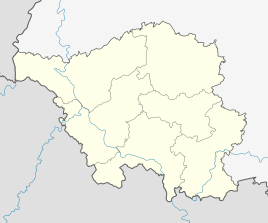Sheep Bridge (Saarbrücken)
|
Sheep bridge
City of Saarbrücken
|
||
|---|---|---|
| Coordinates: 49 ° 13 '27 " N , 7 ° 2' 47" E | ||
| Area : | 2 km² | |
| Residents : | 2935 (May 31, 2012) | |
| Population density : | 1,468 inhabitants / km² | |
| Incorporation : | 1st January 1974 | |
| Postal code : | 66121 | |
| Area code : | 0681 | |
|
Location of Schafbrücke in Saarland |
||
|
Kaiserstraße (former B 40 ) in Schafbrücke
|
||
Schafbrücke (formerly called Goffontaine or Stahlhammer ) is a district of the Saarland capital Saarbrücken and is located in the city district of Halberg .
Geographical location
Schafbrücke is located in the east of the state capital in the valley of the Saar tributary Rohrbach , into which the Grumbach flows in the district . The Kaiserstraße (former Bundesstraße 40 ) and the Mannheim – Saarbrücken railway with the Schafbrücke stop run through the district .
history
The name Schafbrücke goes back to a bridge leading over the Rohrbach, where shepherds from Eschberg washed their sheep in the spring before shearing . Near the bridge was the bridge mill, whose owner had operated an armory and armor grinder before 1580 . In 1752/1753 the mayor of Saarlouis, Pierre Gouvy , built an ironworks with a steel hammer near Schafbrücke . The Gouvy plant, which comes from the Liège area, is named after his home village of Stahlhammer Goffontaine and the developing settlement . The factory ceased operations after 1870; In 1915 the settlement belonging to Scheidt was named Stahlhammer . Other parts of today's district belonged to Bischmisheim until 1960 . A brick factory was operated in this part between 1734 and 1875 ; before 1760 the Grumbacher Mühle was built, from which a sawmill developed in the 19th century. In the course of industrialization, other businesses settled there; as a result, houses were built for the workers. The main focus of the settlement activity was initially the Kaiserstraße, later also the connecting roads to Brebach and Bischmisheim.
In 1951/1952 today's Catholic parish church of St. Theresa was built; In 1957 a Protestant church followed. The formation of independent parishes, as well as the emergence of clubs and schools, contributed to the desire of the population to combine the settlements that had grown together into one parish. In 1960 the community of Schafbrücke was formed as the last community in what is now Saarbrücken's urban area; it originated from parts of the communities of Bischmisheim (Schafbrücke), Scheidt (Neuscheidt, Stahlhammer) and Brebach. Schafbrücke was incorporated into Saarbrücken on January 1st, 1974 as part of the regional and administrative reform in Saarland . The Saarbasar shopping center has been located on the border with Eschberg since 1979 .
On December 31, 2009, Schafbrücke had 2944 residents; In 2008 the district had an area of 200 hectares, 51.3 percent of which was forest.
Infrastructure
- Training center AGV Bau Saar
- Protestant parish Schafbrücke
- Multipurpose hall
Churches
- Catholic Sankt Theresienkirche
- Evangelical Church on Lorenzberg
Personalities
The composer Louis Théodore Gouvy was born in Schafbrücke (then Goffontaine) in 1819. The Schafbrücker Gouvy-Platz was named after Gouvy .
Web links
- Literature on Schafbrücke (Saarbrücken) in the Saarland Bibliography
- Open space in Schafbrücke officially named "Gouvy-Platz". (No longer available online.) In: saarbruecken.de. June 4, 2013 formerly in the original . ( Page no longer available , search in web archives )
Individual evidence
- ↑ Population on August 31, 2012 ( page no longer available , search in web archives ) Info: The link was automatically marked as defective. Please check the link according to the instructions and then remove this notice. (PDF) accessed on September 15, 2012
- ↑ For the history of Schafbrücke see: Richard Hilgers: The new districts in a historical short portrait. In: Rolf Wittenbrock (ed.): History of the city of Saarbrücken. From the time of rapid growth to the present. Volume 2, Saarbrücker Druckerei und Verlag, Saarbrücken 1999, ISBN 3-930843-41-2 , pp. 453-480, here p. 472ff.
- ^ Federal Statistical Office (ed.): Historical municipality directory for the Federal Republic of Germany. Name, border and key number changes in municipalities, counties and administrative districts from May 27, 1970 to December 31, 1982 . W. Kohlhammer, Stuttgart / Mainz 1983, ISBN 3-17-003263-1 , p. 803 .
- ↑ The population of Saarbrücken in 2009. (pdf, 442 kB) (No longer available online.) In: saarbruecken.de. P. 11 , formerly in the original ; accessed on July 3, 2019 . ( Page no longer available , search in web archives )
- ↑ State capital Saarbrücken: District dossier Schafbrücke. (pdf, 21 kB) (No longer available online.) In: saarbruecken.de. P. 1 , formerly in the original ; accessed on July 3, 2019 . ( Page no longer available , search in web archives )
- ^ Training center AGV Bau Saar. Retrieved July 3, 2019 .
- ↑ Evangelical Church Community Schafbrücke: History. In: ekir.de. 2011, accessed July 3, 2019 .
- ↑ Rainer Fromm : About "Jewish republic", "crooked noses" and the Muslims. (Video on YouTube , 4:09 minutes) In: heute-journal . March 12, 2009, accessed July 3, 2019 .



